4-21-15
Close Your Eyes — Artists in Training: Alix Delaporte's Last Hammer Blow
By Diane Sippl
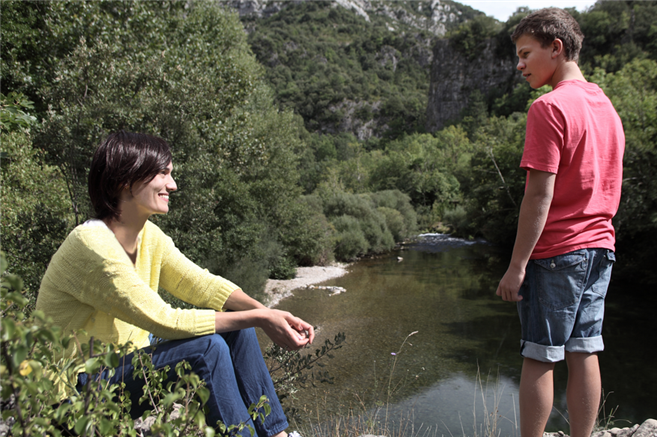
I’m not trying to make big moves in my films, but small ones. I’m very interested in the question, ‘When did we get our first artistic emotion?’ That was my goal.
Alix Delaporte, Writer-Director, The Last Hammer Blow
A gaunt woman and a teen-age boy, hiking alone in the woods, come upon a small lake below and talk about the water. From the cliff above, she jumps in, clothes and all, and he follows suit. She comes to the water’s surface, and floating beside her is her wig. The Last Hammer Blow is about a handful of artists — artists of life — in training to make the most of all they can.
Victor wants more than anything to be selected for a special soccer program, a slot that means severe competition and also leaving home for another school, but even winning it, he might cave in instead to remain at his mother’s side. She’s a “nut,” he calls her, but maybe it’s more than that when she single-handedly decides to quit treatment for her illness. After all, she’s raising Victor by herself in their broken-down trailer. He tries to help by teaching French to the little neighbor in a Spanish family, drilling him patiently and routinely, even if mostly to be near his older sister, Luna, an eyeful for Victor. Yet apparently Victor is also up for an earful: his visits to the Opera Theatre in Montpellier become more frequent. At one point the orchestra conductor tells him, “Music calls up images: a forest, water, wind… just listen, and see how you feel. Close your eyes…”
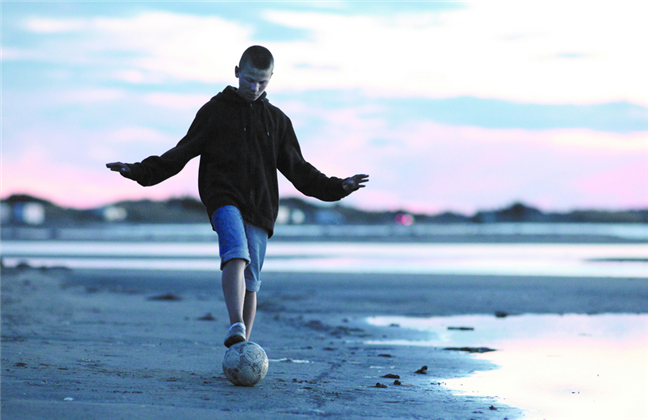
There is something magical about the way Alix Delaporte develops her characters. We may not know people like them, but we want to. Flawed like the rest of us in their behavior and individual traits, they are nonetheless possessed with a certain vision, an intuitive sense of the way they should be, and their conflicts within themselves spur them on. We see them test the waters, take stock, reflect, and act. So simple, it would seem — and yet they so surprise us. Delaporte herself has honed this skill as a cinema artist since her debut feature, Angel and Tony, in which Clotilde Hesme and Gregory Gadebois played the lead roles as a seemingly mismatched romantic couple in a fishing village in Normandy, and as such, they were quite beside themselves. But now at the seaside in the Languedoc region, they are joined by the intriguing Romain Paul who fills nearly every frame of the film with his adolescent mind and heart ticking away in quiet confusion.
Delaporte has been compared to Luc and Jean-Pierre Dardenne in her characters, themes, and style. The Son comes immediately to mind, in which a boy on probation is apprenticed to a carpenter and their intense relationship comes together through their work. Rosetta also begs a comparison, in which a teenage girl must fend for herself and her incapacitated mother living in a trailer park. Yet the Dardenne brothers take on extremely troubled characters who make life miserable for each other; their films hinge on drama and suspense. Delaporte’s are more episodic, more elliptical, and more lyrical at once. Whereas the Dardennes are tense, Delaporte is delicate. Her films are leaner, freer. We are more captivated than shocked by their behavior, more inspired than gratified. We wonder about them long after the film finishes.
The Last Hammer Blow screened for the press at COLCOA French Film Festival this morning, shows there tonight for the public at the Directors Guild of America in Los Angeles, and screens again there tomorrow for those enrolled in the Master Class to be given by Alix Delaporte. What follows are excerpts from the director’s Q&A with various members of the press.
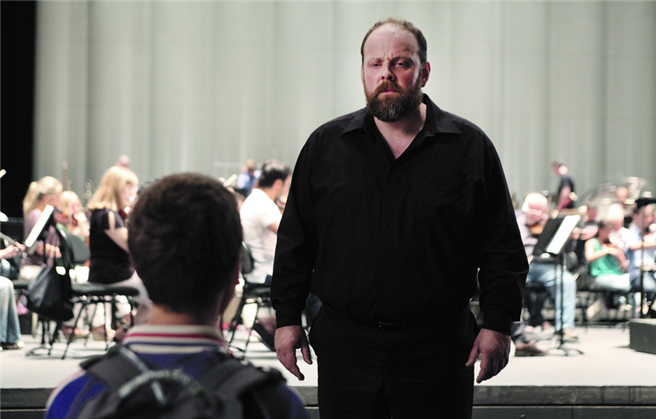
How did you go about casting the phenomenal young Romain Paul?
I saw 70 boys, which is not a lot. At first most of the kids looked pale and sick, so we decided to go to the south of France where the boy would be working, since that’s where the story takes place. Romain had a melancholy in his eyes, a sadness. He’s very pure and honest. He could respect the silence, which I loved. He wasn’t afraid to forget the text. Some kids go very fast, but he didn’t. My idea wasn’t to break in a kid, because he’s in every frame of the movie, so he had to be ready.
How did you decide to use Mahler’s 6th Symphony?
I don’t know anything about classical music. I found out about the hammer blow story, and I knew I wanted a conductor character, so I decided to use it. I was worried Mahler wouldn’t fit with the internal world of the boy. But there is a scene of him with his mom that is so pure, so joyful, so romantic. The scene in the kitchen, and also the scene on the roof, fit. The symphony lasts twenty minutes, in four movements. The first is like going to war — it fits with the kid — and it goes naturally to something more peaceful. There are not many words in my dialogue, so Mahler was like my voice-over to tell the feelings, and it works.
The ending seems open to interpretation. The boy and his mom are on the roof of the
opera house. Did you want him to have
that moment with his mom, who is the most transient?
For me, it’s not that open. We’re following three stories. Nadia wants to stop treatment and is losing faith. She gets dressed to go to town, to the opera, to see the conductor. Victor, her son, gets accepted for special football training. So the first and the second are closed stories. The love story can’t be huge because Victor has a goal, so it remains open. When the dad says, “You look like your mom,” his story is closed. I always take the audience as clever people. I want to bring the two parents together. I don’t tell how they met, but if the man says this, he remembers — he remembers her face. They have to be on the roof because they are close to the dad with his music, but not physically connected.
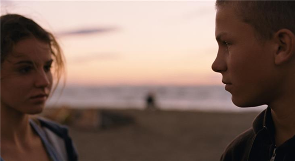
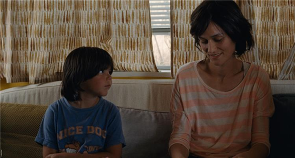
Why did the boy not turn to music more, maybe learn to play an instrument?
You don’t know what’s going to happen in the next months…. I think soccer — for the kids to play well together — is the main goal. If you’re a kid and going to get into that special school, it means you’re not only very skilled but also very competitive, strong, and he doesn’t want to tell his mom he tried out because he doesn’t want to tell her he would be leaving her. I’m not trying to make big moves in my films, but small ones. I’m very interested in the question, ‘When did we get our first artistic emotion?’ That was my goal.
He learns to express his emotions more.
He gets in touch with softness, but he wouldn’t say, ‘Mahler changed my life’. I don’t like big changes. I like to work little by little, like training when you’re an artisan — you don’t get it all at once, jump to big emotions. I re-read my dialogue a week after I wrote it to get rid of the words and give the script action. His playing the c.d. for his mom is more effective than talking. That’s my work, the most important part of my work — to show it, and use less and less words.
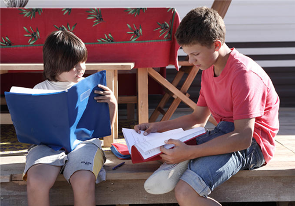
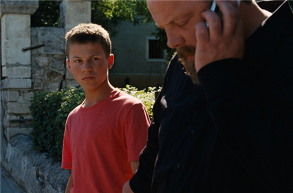
What was it like working with the orchestra?
I went to the Ukraine and heard them and then they came to France for one month. (They were paid for that month what they would be paid for a year in the Ukraine.) The more difficult part was their haircuts. There were 110 of them, and they came by bus to France. Grégory — the actor who played the conductor — didn’t know anything about classical music, just the tempo and the beat, and he got it. He had a Russian teacher from the conservatory. They met four times for coffee. His teacher said, ‘I can train anyone to be a conductor… within three-to-five years.’ Grégory said, ‘Okay…’ He really knows what’s essential. He knew the most important was not to be a conductor, but to be a non-father, and then a father. We shot on 35mm, not video, so shooting was important and we wanted it to be real. So Grégory decided to focus on fatherhood, and he got it.
Your film has a quiet charm, especially in the smaller moments.
In the scenes without words, the feelings are deeper, because they’re your feelings. When you get rid of the words, you give liberty to the audience and respect to the actors —your trust that they can show it all, when they’re good. I don’t direct actors; I just give them confidence. I wanted Paul Romain to be happy on the set, to push the limits. The rest was all written in the script already. There was nothing Paul had to create; he just had to be there and play with the others. It’s like falling in love, using the kid in every frame — and difficult, because he was very inside himself. When the child he tutored told him, ‘Your mom is going to die’, I asked him to think of his own mom dying. It worked — it opened him a bit. But he said he felt he was cheating. ‘No’, I said,.‘You’re acting.’
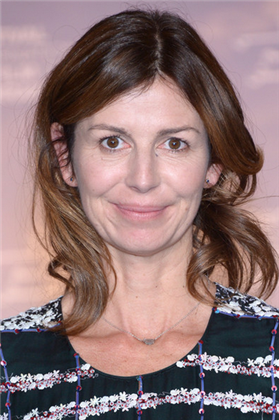
P.S. On 4-28-25, the news: The Last Hammer Blow was awarded the COLCOA LAFCA Critics Award by the Los Angeles Film Critics Association jury at the 19th annual COLCOA French Film Festival. The film had its North American Premiere at COLCOA. The critics jury remarked, “We were unanimous in our esteem of this visually stunning, restrained piece of cinema by Alix Delaporte. The film was emotionally rich yet narratively spare. The Last Hammer Blow tells an indelible story in the small spaces between a boy and his parents.”
The Last Hammer Blow
Director: Alix Delaporte; Producer: Hélène Cases; Screenplay: Alix Delaporte, Alain Le Henry; Cinematographer: Claire Mathon; Editor: Louise Decelle; Music: Evgueni Galperine, Sacha Galperine; Sound: Pierre Tucat, Arnaud Rolland, Eric Tisserand; Production Design: Helen Ustaze; Costume Design: Dorothee Guiraud.
Cast: Romain Paul, Clotilde Hesme, Grégory Gadebois, Candela Pena, Farida Rahouadj, Farid Bendali, Tristan Ulloa, Mireia Vilapuig, Victor Sanchez.
Color, 35mm, 83 min. In French and Spanish with English subtitles.